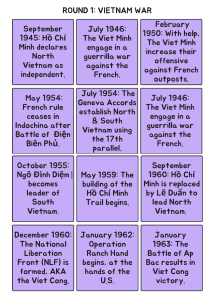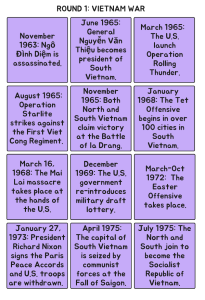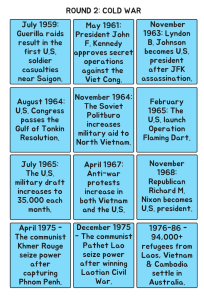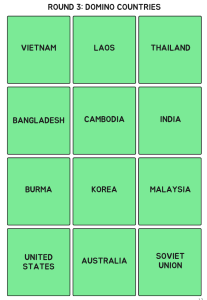50 The Vietnam War by Montana Thai
1. Domino theory – with dominoes!

Dominoes falling by Kurt:S,Flickr, (CC BY 2.0)
| Curriculum Context | VCE Unit 2: The Changing World Order. Area of Study 1: Causes, course and consequences of the Cold War (VCAA, 2020). |
| Historical Context | The Vietnam War as a significant event in and a product of the Cold War. |
| Historical Thinking Concepts | Sequencing chronology
Analysing causes and effect |
| Learning Intentions | Understand the cause and course of the Vietnam War in context of the Cold War, including the idea of the domino theory and the strategies of containment that drove actions of the United States regarding the Vietnam War. |
Activity
This is a three-round domino activity. You will be allocated a paper domino that has an event printed on it.
For round one, you will conduct 15 minutes of research about your event, and then we will convene as a class to line your dominoes up, in order of events relating to the Vietnam War. Everyone will briefly present their notes about their respective events.
For round two, your teacher will then produce more dominoes, and you will again conduct research about the one you are assigned. You will work collaboratively to place them accordingly to highlight the events of the Vietnam War in context of the Cold War.
In round three, dominoes with the names of countries involved in the hypothetical domino theory will be handed out and integrated into the sequence. Once a majority vote is conducted to confirm that most of the class agrees with the sequence, the teacher will quote 34th president of the United States of America, Dwight D. Eisenhower (cited in Office of the Federal Register, General Services Administration, 1954, p. 384), by announcing:
“You have a row of dominoes set up, you knock over the first one, and what will happen to the last one is the certainty that it will go over very quickly”.
You will knock the first domino over and discuss the ideas behind Domino Theory.
Round 1: Vietnam War


Round 2: Cold War

Round 3: Domino Countries
References
Office of the Federal Register, General Services Administration. (1954). Public Papers of the Presidents of the United States: Dwight D. Eisenhower (1954). [Government document]. Office of the Federal Register, National Archives and Records Administration. https://www.govinfo.gov/app/details/PPP-1954-book1
VCAA. (2020). VCE Study Design: History 2022-2026. Victorian Curriculum and Assessment Authority. https://www.vcaa.vic.edu.au/curriculum/vce/vce-study-designs/history/Pages/index.aspx
2. Evaluating contextual perspectives of the Vietnam War

| Curriculum Context | VCE Unit 2: The Changing World Order. Area of Study 1: Causes, course and consequences of the Cold War (VCAA, 2020). |
| Historical Context | The Vietnam War as an event that impacted multiple nations and peoples. |
| Historical Thinking Concepts | Using historical sources as evidence
Determining historical significance |
| Learning Intentions | Analyse sources to explore multiple perspectives about the Vietnam War, and use them to respond to evaluative questions about the event.
Synthesise knowledge to write a cohesive extended response to a question relating to historical significance. |
In groups of 2-3, you will be analysing ten different historical sources relating to the Vietnam War at designated ‘stations’. Each station will feature either a primary or secondary source, covering multiple perspectives relating to the people who were directly involved or indirectly connected to the war effort. There are 1-2 questions located at each station that you must answer. You will have 8 minutes at each station to view, discuss, and answer before moving onto the next station.
In the remaining time, you will then write an extended response to answer the question “What is the historical significance of the Vietnam War, in the context of the Cold War?”, making explicit reference to the domino theory, and how the war had far-reaching impacts for multiple nations. You must reference at least two perspectives you have engaged with from the sources. A model response will be provided to guide you regarding the appropriate length and expected conventions you will follow in your response. The dominoes used in the last lesson will also be available for use.
Source 1: VIEW – Australia
Anti-Vietnam War protest at Wynyard Street, Sydney, NSW (8 April 1965) by SEARCH Foundation and State Library of New South Wales, Sydney, Australia (CC BY 4.0) via Wikimedia Commons.
- What does this source indicate about the feelings some Australians felt on home soil, whilst Australian soldiers were fighting in Vietnam?
- What might the term “dirty” imply when referring to the Vietnam War?
Source 2: WATCH – North Vietna
Vietnam’s Proclamation of independence by Ho Chi Minh in 1945, Democratic Republic of Vietnam – BCC. (6:48-7:36)
- Imagine you are a North Vietnamese citizen listening to this part of Ho Chi Minh’s speech, freshly liberated from a 67-year-long French rule. How would it make you feel about him?
Source 3: READ – Laos
Laos, 1959–1975: read the first paragraph on p. 447.
- What might the term “victim of geography” imply about the nature and causes of Laos’ involvement in the Vietnam War?
Source 4: VIEW – Soviet Union
Klucis, Выше знамя Маркса, Энгельса, Ленина и Сталина!. (1936) by Gustavs Klucis, (CC0), via Wikimedia Commons.
- Do you think it would have been easy for citizens to question or oppose the foundation of communism in their nation? Why or why not?
Source 5: WATCH – South Vietnam
South Vietnamese Veterans’ Perspective on End of Vietnam War – Iowa PBS.
- What does this source reveal about the true effectiveness of the Paris Peace Accords for those involved in the Vietnam War?
Source 6: READ – Cambodia
Cambodia, 1967–1975: Read the first two paragraphs on p. 309.
- What does this source reveal about the Cambodia-Vietnam relationship during the war?
Source 7: WATCH – United States of America
Story of survival, Vietnam War veteran Gary Rodgers – NBC4 Columbus. (0:00 -2:50)
- Judging the emotions that Gary expresses, what does this source reveal about the lifelong impacts of those who fought during the Vietnam War?
Source 8: VIEW – Mai Lai Civilians
My Lai massacre woman and children
- What does this photograph reveal about the primary victims of the Mai Lai Massacre?
- What emotions do you think the women and children in this photograph may have been feeling when this photograph was taken, moments before their executions?
Source 9: WATCH – Women of War
Experiences of a Nurse During the Vietnam War. (0:00 and 1:29)
- How did nurses use their femininity in a positive way when treating their patients?
Source 10: WATCH – Australia
Francis Adrian Roberts – Home – Australian Department of Veterans’ Affairs.
- What does this story reveal about some of the soldier motivations about joining the war effort and their perceptions of Vietnamese people?
References
Anti-Vietnam War protest at Wynyard Street, Sydney, NSW. (8 April 1965). SEARCH Foundation and State Library of New South Wales, Sydney, Australia (CC BY 4.0) via Wikimedia Commons.
Australian Department of Veterans’ Affairs. (2021, July 19). Francis Adrian Roberts – Home. YouTube. https://www.youtube.com/watch?v=Xww6KaBPUE0
B CC. (2018, November 20). Vietnam’s Proclamation of Independence by Ho Chi Minh in 1945, Democratic Republic of Vietnam. YouTube. https://www.youtube.com/watch?v=7aBnz6GiT1g
Iowa PBS. (2015, October 22). Experiences of a Nurse During the Vietnam War. YouTube. https://www.youtube.com/watch?v=1PdXHR7HRyk
Iowa PBS. (2018, January 20). South Vietnamese Veterans’ perspective on end of Vietnam War. YouTube. https://youtu.be/icC06mAgBRY
Klucis, Выше знамя Маркса, Энгельса, Ленина и Сталина!. (1936) by Gustavs Klucis, (CC0), via Wikimedia Commons.
My Lai massacre woman and children. (16 March 1968) by Ronald L. Haeberle (Library of Congress), Washington DC, United States of America (CC0) via Wikimedia Commons.
NBC4 Columbus. (2021, November 10). Story of survival, Vietnam War veteran Gary Rodgers. YouTube. https://www.youtube.com/watch?v=EiPwieDeKAw
Paul, C., Clarke, C. P., Grill, B., & Dunigan, M. (2013). Paths to victory: Detailed insurgency case studies. RAND Corporation. http://www.jstor.org/stable/10.7249/j.ctt5hhsjk.23
VCAA. (2020). VCE Study Design: History 2022-2026. Victorian Curriculum and Assessment Authority. https://www.vcaa.vic.edu.au/curriculum/vce/vce-study-designs/history/Pages/index.aspx



